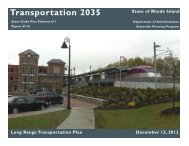156: EDA Public Works in RI, 1996-2000 - State of Rhode Island ...
156: EDA Public Works in RI, 1996-2000 - State of Rhode Island ...
156: EDA Public Works in RI, 1996-2000 - State of Rhode Island ...
Create successful ePaper yourself
Turn your PDF publications into a flip-book with our unique Google optimized e-Paper software.
Appendix B:<br />
APPLYING MULTIPLIERS: A SAMPLE CALCULATION<br />
The economic multipliers used <strong>in</strong> the <strong>Rhode</strong> <strong>Island</strong> CEDS to determ<strong>in</strong>e the<br />
full impact <strong>of</strong> projects that are candidates for priority list<strong>in</strong>g come from the<br />
Regional Input-Output Model<strong>in</strong>g System (<strong>RI</strong>MS) developed by the U.S.<br />
Department <strong>of</strong> Commerce. They are <strong>of</strong> two types, “direct effect” and “f<strong>in</strong>al<br />
demand.” The follow<strong>in</strong>g discussion shows how to apply them <strong>in</strong> a hypothetical<br />
situation – the construction <strong>of</strong> a new import/export center <strong>in</strong> the Port <strong>of</strong><br />
Providence.<br />
Accord<strong>in</strong>g to the <strong>RI</strong>MS model, the category “new construction” has a<br />
direct-effect employment multiplier <strong>of</strong> 2.3568, and a f<strong>in</strong>al-demand multiplier <strong>of</strong><br />
30.1 jobs for every million dollars <strong>in</strong>vested. So, every s<strong>in</strong>gle job <strong>in</strong> “new<br />
construction” will yield an additional 1.3568 jobs elsewhere <strong>in</strong> the economy<br />
(<strong>in</strong>direct and <strong>in</strong>duced employment). These are the jobs added by suppliers,<br />
distributors, service providers and other producers to meet the <strong>in</strong>creased<br />
demand result<strong>in</strong>g from the project.<br />
If 84 workers are hired to build the import/export center, the follow<strong>in</strong>g<br />
impact would be expected on jobs throughout the <strong>Rhode</strong> <strong>Island</strong> economy:<br />
84 jobs on site x 2.3568 = 198 total R.I. jobs<br />
These 198 jobs would <strong>in</strong>clude the orig<strong>in</strong>al 84 (direct employment), plus 114<br />
additional jobs <strong>in</strong> other sectors <strong>of</strong> the economy (<strong>in</strong>direct and <strong>in</strong>duced<br />
employment).<br />
If the new center cost $6.3 million to build, the impact on employment<br />
dur<strong>in</strong>g the construction period could be calculated by the f<strong>in</strong>al demand method as<br />
follows:<br />
$6.3 million <strong>in</strong> demand x 30.1 jobs/$1 million = 190 total R.I. jobs<br />
Aga<strong>in</strong>, the 190 jobs would <strong>in</strong>clude direct, <strong>in</strong>direct and <strong>in</strong>duced employment. The<br />
discrepancy between the numbers <strong>of</strong> jobs calculated by the two methods is<br />
<strong>in</strong>significant and probably due to round<strong>in</strong>g.<br />
These jobs would be generated until construction was completed. If<br />
planners wanted to estimate direct, <strong>in</strong>direct and <strong>in</strong>duced employment aris<strong>in</strong>g from<br />
the operation <strong>of</strong> the import/export center, i.e., the post-construction, “long-range”<br />
jobs, they would need to estimate the center’s operat<strong>in</strong>g expenses and then<br />
identify the proper f<strong>in</strong>al-demand multiplier (<strong>in</strong> this case, “bus<strong>in</strong>ess services” at<br />
39.7 jobs per $1 million <strong>in</strong>vested).<br />
B-1

















